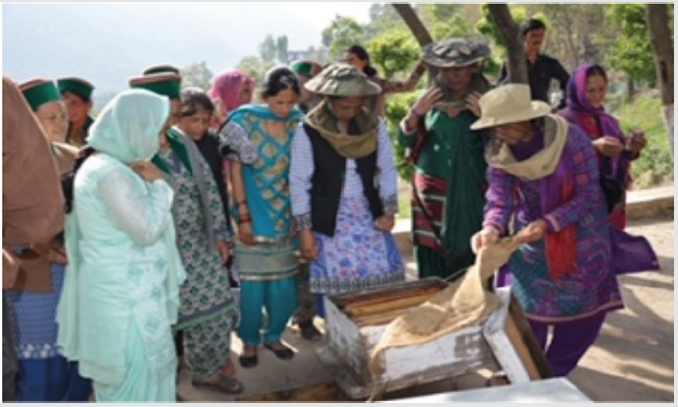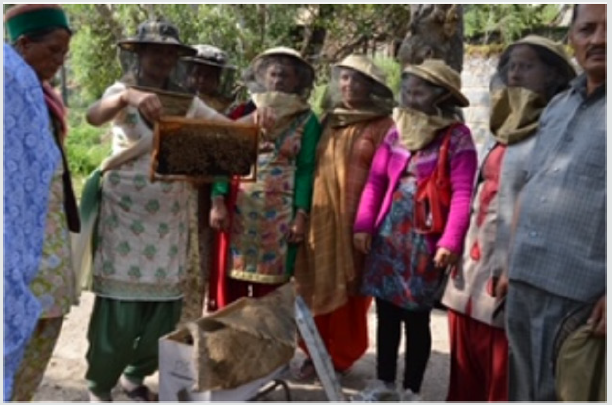
Lupine Publishers Group
Lupine Publishers
Menu
ISSN: 2637-4676
Short Communication(ISSN: 2637-4676) 
Beekeeping as an Entrepreneurship Volume 7 - Issue 4
Amarjit K Nath1*, Meena Thakur1 and Satish K Sharma2
- 1Dr YSP University of Horticulture & Forestry, Nauni Solan HP 173230, India
- 2Biochemist of Directorate of Research SKAUST-J J& K, India
Received: October 01, 2019; Published: October 11, 2019
Corresponding author: Amarjit K Nath, Pr Biochemistry, Biotechnology, Dr YSP University of Horticulture & Forestry, Nauni Solan, India
DOI: 10.32474/CIACR.2019.07.000270
Short Communication
It has been projected as per United Nation that India’s population could surpass that of China’s around 2024, two years later than previously estimated and is projected to touch 1.5 billion in 2030. Because of it, India will have to face two major challenges, provide employment to youth and nutritive food in adequate quantity to people. Beekeeping industry can play an important role in addressing these challenges. Beekeeping is maintenance of honeybee colonies, commonly in manmade Beehives. According to the National Commission on Agriculture, India needs minimum 200 million honeybee colonies just to pollinate and increase productivity of 12 major crops which are self-sterile and need insect pollination. This will provide employment to 215 lakh people and produce 10 million tons of honey. Bee keeping is a very attractive / lucrative / fascinating rural Agri-horticulture based entrepreneurship. It doesn’t need any sophisticated technology, high capital investment or infrastructure. It suits well in the integrated agricultural system as an allied activity to increase the economy of farming community. A bee keeper keeps bees in order to collect honey and other products that the hive produces, to pollinate crops or to produce bees for sale to other bee keepers. The various benefits of keeping include; providing self-employment to rural and forest based population, production of honey, pollen, beeswax, venom and royal jelly, providing employment to rural educated youths in collecting, processing and marketing of bee-products and it is most important in cross- pollination of various agriculture and horticultural crops, thereby improving their quality and increasing yields (Figure 1).
India has taken the lead in using honeybees for pollination, to boost yield and improve quality of the produce in south and southeast Asia. Over centuries, farmers in remote and inaccessible areas of the Himalayan region have developed techniques for keeping and benefiting from the indigenous A. cerana. These bees can be maintained in hives using simple resources and can be kept even at altitudes up to 3000 m because they are adapted to the harsh conditions of the high mountain areas. A. cerana is well suited both to the climatic conditions in the region and to the farming practices which are typical of these marginal areas. A. mellifera is an exotic bee which was introduced to India in 1962 and has 4-5 times more honey producing potential than other bees. At present both the hive species are being used in modern bee keeping and lot of honey is also being collected from the wild bees (A. Dorsata and A. Florea). In world, on an average, per capita consumption of honey is 200 grams [1]. Whereas in Asia, Japan has the highest per capita consumption of honey i.e. 600 grams. In India honey is not taken in the form of food as its per capita per annum consumption is only 8.00 grams. But in other countries like Germany, per capita consumption of honey is about 1800 grams [2]. The estimated annual production of honey in India is about 85000 metric tons and substantial quantity of it is being exported to other countries.
In June 2010, EU/EC banned import of Indian honey due to presence antibiotics, lead and lack of traceability of honey source. Inadequate knowledge of quality parameters of the European market, missing know-how of international “Good Agricultural Practices” (GAP) / “Good Beekeeping practices” (GBP) lead to wrong application / use of antibiotics and other compounds in beekeeping, inadequate practice of international hygiene requirement (for example deficiencies in hygiene management, use of HACCP and ISO 22000), insufficient capacities of testing laboratories as per European requirements in India, bee medicines were not allowed in EU, but they are freely available in Indian markets. Apart from its missing infrastructure for training and consulting in the areas described above also remains a major stumbling block. Though, honey bees are best known for honey production, their main role in nature is to pollinate various agricultural and horticultural crops and to increase their yield per unit area, per unit time, per unit of input and improve their quality. Therefore, for past 3-4 decades, utilizing honey bees to pollinate large number of agricultural and horticultural crops to increase per acre yield has become a routine practice in many developed countries. Agricultural scientists in America and Europe have estimated that the value of the increased crop yields due to honey bee pollination is several times more than the value of the honey and beeswax the honey bees produce. For commercial bee keeping one should start with minimum 100 bee colonies. Net income from stationary bee keeping is 4, 24,168/-. For migratory bee keeping total income is 10, 04,800. Apart from its revenue can also be generated from other valuable products obtained from bee keeping (Figure 2).
Bee wax is a natural wax produced by honey bees of genus Apis. Bee wax is esters of fatty acids with long chain alcohols. It is obtained from the capping collected during honey extraction. It is mainly used for preparing comb foundation sheets; it also has uses in cosmetics, pharmaceuticals, perfume industry etc. Bee wax candles can be made. Comb foundation sheet is cut into appropriate sizes of about 10 cm length and 5 cm width; a thread of appropriate length is dipped for few seconds in heated bee wax and left to dry. The thread is placed between the already cut comb foundation sheets and it is folded and rolled so that thread is between the sheets. Diya’s can also be made from bee wax, being non-toxic and environment friendly it is better than oil-based Diya’s. Candles can also be made in shot glasses, they are unique and attractive can fetch good market price. Other value added products like lip balm, wood polish, body lotions, massage bars can also be made from bee wax.
Bee pollen is a ball or pellet of field gathered flower pollen packed by worker honeybees and used as the primary food source for the hive. It consists of simple sugars, protein, minerals vitamins fatty acids and a small percentage of other components, it is also called bee bread or ambrosia. It is stored in brood cells mixed with saliva and sealed with a drop of honey. Bee pollen can be trapped scrapped from honey bee by installing a pollen trap at the entrance of hive it can be processed as pollen granules or capsules and used as human food as it is fermented and hence more beneficial. Fibrous substances and pectin are found in pollen. 3. Propolis called bee glue is a natural dark sticky resinous material that honey bees produce by mixing saliva and beeswax with exudates gathered from tree buds, sap flows or other botanical sources, it is sticky at 20˚C and above temperatures and at lower temperatures it is hard and brittle.. It can be collected by placing plastic mesh on the hive for the bees to fill the cracks with propolis. Commonly called nature’s penicillin it has antimicrobial, antiparasitic, antiviral and antioxidant properties and is also used in veterinary products, varnishes and cosmetics. Propolis is used for making liquid extracts. Popolis or its extracts can be taken with or used as additive to other medicinal dietetic or cosmetic preparations and can be easily included in tablets or sweets.
Bee venom is stored in poison sac attached to sting of worker bee. A 2-week-old bee has maximum venom in this poisonous sac. It is given as a shot for rheumatoid arthritis, nerve pain (neuralgia) , multiple sclerosis, reducing the reaction to bee stings in people who are allergic ( desensitization) to them( venom immune therapy), swollen tendons (tendonitis), muscle conditions such as fibro myositis and enthesis’s and also in prevention of cancer.
Royal Jelly is secreted by gland of nurse bees of 6-12 days and collected by a suction pump. Royal jelly exhibits a variety of pharmacological activities, including anti-tumour, antioxidative anti-fatigue etc. It is thought to alleviate many aging related diseases. Secondary products which are partially or wholly made up of primary bee products are referred as value added products from bee keeping. This would create business opportunities for non-beekeepers and those who are willing to choose alternatives. Honey can be used as sweetener instead of table sugar in juices as is natural and more nutritious, Honey jelly, Rose honey, Honey beer, Honey cream Honey butter etc are some examples.
References

Top Editors
-

Mark E Smith
Bio chemistry
University of Texas Medical Branch, USA -

Lawrence A Presley
Department of Criminal Justice
Liberty University, USA -

Thomas W Miller
Department of Psychiatry
University of Kentucky, USA -

Gjumrakch Aliev
Department of Medicine
Gally International Biomedical Research & Consulting LLC, USA -

Christopher Bryant
Department of Urbanisation and Agricultural
Montreal university, USA -

Robert William Frare
Oral & Maxillofacial Pathology
New York University, USA -

Rudolph Modesto Navari
Gastroenterology and Hepatology
University of Alabama, UK -

Andrew Hague
Department of Medicine
Universities of Bradford, UK -

George Gregory Buttigieg
Maltese College of Obstetrics and Gynaecology, Europe -

Chen-Hsiung Yeh
Oncology
Circulogene Theranostics, England -
.png)
Emilio Bucio-Carrillo
Radiation Chemistry
National University of Mexico, USA -
.jpg)
Casey J Grenier
Analytical Chemistry
Wentworth Institute of Technology, USA -
Hany Atalah
Minimally Invasive Surgery
Mercer University school of Medicine, USA -

Abu-Hussein Muhamad
Pediatric Dentistry
University of Athens , Greece

The annual scholar awards from Lupine Publishers honor a selected number Read More...






